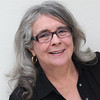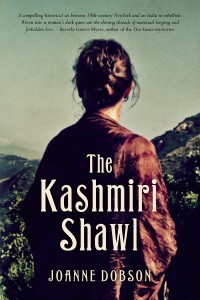 Relevant History welcomes Joanne Dobson, a mystery novelist and scholar of American women’s literature. Her six-book Professor Karen Pelletier mystery series won an Agatha nomination and a Noted Author of the Year award from the New York State Library Association. The Kashmiri Shawl is her first venture into the genre of historical fiction. A retired professor of American Literature, Joanne is a specialist in Emily Dickinson and other nineteenth-century American women writers. Currently she teaches in National Endowment for the Humanities and Fulbright Fellowship International summer programs at Amherst College. She also teaches Creative Writing at the Hudson Valley Writers Center. For more information, check her web site, and look for her on Facebook and Twitter.
Relevant History welcomes Joanne Dobson, a mystery novelist and scholar of American women’s literature. Her six-book Professor Karen Pelletier mystery series won an Agatha nomination and a Noted Author of the Year award from the New York State Library Association. The Kashmiri Shawl is her first venture into the genre of historical fiction. A retired professor of American Literature, Joanne is a specialist in Emily Dickinson and other nineteenth-century American women writers. Currently she teaches in National Endowment for the Humanities and Fulbright Fellowship International summer programs at Amherst College. She also teaches Creative Writing at the Hudson Valley Writers Center. For more information, check her web site, and look for her on Facebook and Twitter.
*****
 The Kashmiri Shawl, my latest novel and first historical, was inspired by at least three different sources: a National Geographic article, believe it or not, on nineteenth-century narrow-gauge Indian railroads; the life of Emily Chubbuck, the third wife of Adoniram Judson, famed nineteenth-century missionary to Burma, who returned to New York when widowed and resumed a successful career as writer and poet; and—Jane Eyre.
The Kashmiri Shawl, my latest novel and first historical, was inspired by at least three different sources: a National Geographic article, believe it or not, on nineteenth-century narrow-gauge Indian railroads; the life of Emily Chubbuck, the third wife of Adoniram Judson, famed nineteenth-century missionary to Burma, who returned to New York when widowed and resumed a successful career as writer and poet; and—Jane Eyre.
You remember Jane Eyre, don’t you? The novel wasn’t all about Jane and Mr. Rochester. Jane had another suitor. In what has got to be the lamest marriage proposal in the history of the English language, Jane’s pious cousin, St. John Rivers, commands her to marry him and to come with him to India: “God and nature,” he intones, “intended you for a missionary’s wife…you are formed for labour, not for love. A missionary’s wife you must—shall be. I claim you—not for my pleasure, but for my Sovereign’s service.” In other words, she’s not beautiful and he doesn’t love her. But she would be a great little mission worker. “Jane, you are docile, diligent, disinterested, faithful, constant, and courageous…your assistance will be to me invaluable.”
Jane turns him down. I don’t blame her, and I find her reason interesting: “If I were to marry you, you would kill me. You are killing me now.” But almost immediately she deflects the cause of her certain death away from the man himself and onto India: “I am convinced that go when and with whom I would, I should not live long in that climate.” Her death would be implicit in her role as missionary wife. And St. John’s sister backs her up: “’Madness,’ she exclaimed upon hearing of his proposal, “you would not live three months there, I am certain…Think of the…incessant fatigue: where fatigue kills even the strong; and you are weak.’” Jane would be “grilled alive in Calcutta,” Diana concludes.
I came away from my reading of Jane Eyre with the assumption that the Indian climate was even deadlier than Jane’s would-be husband. What, I asked myself in a frenzy of inspiration, would have happened to Jane if she’d said yes to St. John Rivers and gone to India as his wife? And thus was born Anna Wheeler, the protagonist of The Kashmiri Shawl—a missionary wife (and poetess) fleeing her own “deadly” husband by train through a lethal Indian landscape.
 But, no; maybe the landscape was not so lethal. In researching The Kashmiri Shawl, I was struck to find actual missionaries and their actual wives in India enthusing in letters home about the beauty and healthiness of the local climate. As early as 1812, Ann Hasseltine Judson, Adoniram’s first wife, wrote home reporting that they had come close to land and that the sight “was truly delightful…the fertile shores of India—the groves of orange and palm trees…the smell which proceeds from them is fragrant beyond description.”
But, no; maybe the landscape was not so lethal. In researching The Kashmiri Shawl, I was struck to find actual missionaries and their actual wives in India enthusing in letters home about the beauty and healthiness of the local climate. As early as 1812, Ann Hasseltine Judson, Adoniram’s first wife, wrote home reporting that they had come close to land and that the sight “was truly delightful…the fertile shores of India—the groves of orange and palm trees…the smell which proceeds from them is fragrant beyond description.”
In a letter from Mynpoorie in the early 1850s, the Reverend John E. Freeman reports that his wife, “Lizzie…enjoys excellent health, and looks fresh and cheerful. We ride daily, labour hard, and all goes smoothly and happily.”
Lizzie Freeman, herself, reports that she “walked this morning five miles. The cool bracing air and exercise gave me a fine appetite and red cheeks…I feel quite as well as in my best days at home.”
In early May 1857, Maria Campbell, at Fatehgarh, writes to her brother, “It is now very warm, you would say hot, but has been a very healthy season.”
Unfortunately, in actual history, Maria Campbell’s “healthy season” was soon to turn deadly for her and Lizzie Freeman and the other missionaries then at the Fatehgarh Mission. They were among the multitudes killed on both sides during the horrific Great Uprising of 1857, more familiarly known as the Sepoy Mutiny. Their fates, however, had nothing to do with anything lethal in the Indian climate.
So, no: Neither Jane Eyre nor Anna Wheeler has to be “grilled alive in Calcutta.” In fact, Anna finds herself “translated” in delightful ways by India. “The weather… was Biblical, hot and dry in season, with the scent of spices in the air. She loved the lilt of the languages…she took pleasure in the beauty of the people and their graceful ways…she loved the chants and bells and drums of festivals in the temples; she could not get enough of the cardamom, turmeric, and saffron, the mangoes and pomegranates.” She thrives in India. And so, too, might have Jane Eyre.
But, Reader, I’m truly glad she married Mr. Rochester, instead.
*****
A big thanks to Joanne Dobson!
**********
Did you like what you read? Learn about downloads, discounts, and special offers from Relevant History authors and Suzanne Adair. Subscribe to Suzanne’s free newsletter.



